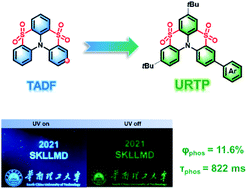Converting molecular luminescence to ultralong room-temperature phosphorescence via the excited state modulation of sulfone-containing heteroaromatics†
Abstract
Manipulating the molecular orbital properties of excited states and the subsequent relaxation processes can greatly alter the emission behaviors of luminophores. Herein we report a vivid example of this, with luminescence conversion from thermally activated delayed fluorescence (TADF) to ultralong room-temperature phosphorescence (URTP) via a facile substituent effect on a rigid benzothiazino phenothiazine tetraoxide (BTPO) core. Pristine BTPO with multiple heteroatoms shows obvious intramolecular charge transfer (ICT) excited states with small exchange energy, featuring TADF. Via delicately functionalizing the BTPO core with peripheral moieties, the excited states of the BTPO derivatives become a hybridized local and charge transfer (HLCT) state in the S1 state and a local excitation (LE) dominated HLCT state in the T1 state, with enlarged energy bandgaps. Upon dispersion in a polymer matrix, the BTPO derivatives exhibit a persistent bright green afterglow with long lifetimes of up to 822 ms and decent quantum yields of up to 11.6%.



 Please wait while we load your content...
Please wait while we load your content...